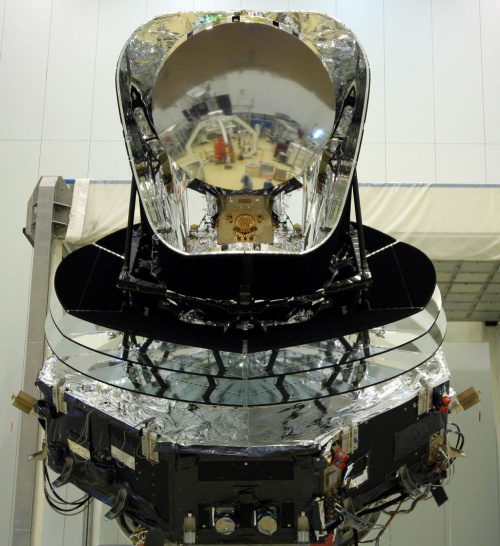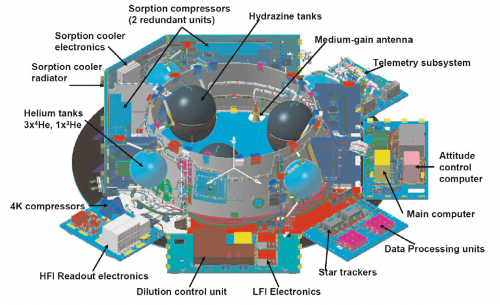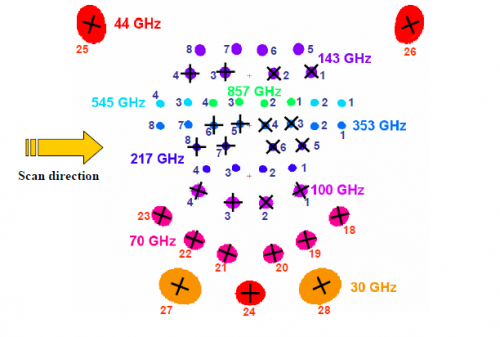The satellite
Contents
[hide]Overview[edit]
The Planck satellite was designed, built and tested around two major modules:
- The payload module containing an off-axis telescope with a projected diameter of 1.5m, focussing radiation from the sky onto a focal plane shared by detectors of the LFI and HFI, operating at 20K and 0.1K respectively; a telescope baffle that simultaneously provides stray-light shielding and radiative cooling; and three conical “V-groove” baffles that provide thermal and radiative insulation between the warm service module and the cold telescope and instruments.
- The service module containing all the warm electronics servicing instruments and satellite; and the solar panel providing electrical power. It also contains the cryocoolers, the main on-board computer, the telecommand receivers and telemetry transmitters, and the attitude control system with its sensors and actuators. The most relevant technical characteristics of the Planck spacecraft are detailed in the Table bellow.
Table. Planck satellite characteristics.
| Diameter | 4.2 m | Defined by the solar array |
| Height | 4.2 m | |
| Total mass at launch | 1912 kg | Fuel mass = 385 kg at launch; He mass = 7.7 kg |
| Electrical power demand (avg) | 1300 W | Instrument part: 685 W (Begining of Life), 780 W (End of Life) |
| Minimum operational lifetime | 18 months | Planck operated for 32 months with both instruments; the LFI continues surveying the sky |
| Spin rate | 1 rpm | $\pm 0.6$ arcmin/sec (changes due to manoeuvers); stability during inertial pointing rpm/h |
| Max angle of spin axis to Sun | 10 deg | To maintain the payload in the shade; default angle is 7.5 deg |
| Max angle of spin axis to Earth | 15 deg | To allow communication to Earth |
| Angle between spin axis and telescope boresight | 85 deg | Max extent of FOV∼ 8 deg |
| On-board data storage capacity | 32 Gbit | Two redundant units (only one is operational at any time) |
| Data transmission rate to ground (max) | 1.5 Mbps | Within 15 deg of Earth, using a 35 m ground antenna |
| Daily contact period | 3 h | The effective real-time science data acquisition bandwidth is 130 kbps |
For more information, see #planck2011-1-1.
The service module[edit]
The service module provides the various equipment and instruments housed in it with suitable mechanical and thermal environments during launch and orbit. It is formed by an octagonal box, built around a conical tube, which supports the following subsystems intervening in flight operations:
- Command and data management.
- Attitude control and measurement.
- Power control.
- Reaction control.
- Telemetry, tracking and command.
- Thermal control.
The service module contains all the warm satellite and payload electronic units, with the only exception of the box containing JFETs for impedance-matching to the HFI bolometers, which is mounted on the primary reflector support panel, to allow the operation of the JFETs at an optimal temperature of ∼130 K. The service module holds:
- Main computer
- Attitude control computer
- Data processing units
- Star trackers
- LFI electronics
- Dilution control unit
- HFI readout electronics
- 4K compressors
- Helium tanks: 36000 litres of He, and 12000 litres of He gas are stored in four high-pressure tanks.
- Sorption cooler radiator
- Sorption cooler electronics
- Sorption compressors (2 redundant units)
- Hydrazine tanks
- Medium-gain antenna
- Telemetry subsystem.
For more information, see #tauber2010a.
Thermal design[edit]
The performance of the Planck instruments in space is enabled by their low operating temperatures, 20 K for LFI and 0.1 K for HFI, achieved through a combination of passive radiative cooling and three active coolers. The scientific requirement for very broad frequency coverage led to two detector technologies with widely different temperature and cooling needs. Active coolers could satisfy these needs; a helium cryostat, as used by previous cryogenic space missions (IRAS, COBE, ISO, Spitzer, AKARI), could not. Radiative cooling is provided by three V-groove radiators and a large telescope baffle. The active coolers are a hydrogen sorption cooler (<20 K), a He Joule-Thomson cooler (4.7 K), and a He-He dilution cooler (1.4 K and 0.1 K). The flight system was at ambient temperature at launch and cooled in space to operating conditions. The HFI bolometer plate reached 93 mK on 3 July 2009, 50 days after launch. The solar panel always faces the Sun, shadowing the rest of Planck, and operates at a mean temperature of 384 K. At the other end of the spacecraft, the telescope baffle operates at 42.3 K and the telescope primary mirror operates at 35.9 K. The temperatures of key parts of the instruments are stabilized by both active and passive methods. Temperature fluctuations are driven by changes in the distance from the Sun, sorption cooler cycling and fluctuations in gas-liquid flow, and fluctuations in cosmic ray flux on the dilution and bolometer plates. These fluctuations do not compromise the science data.
The contrast between the high power dissipation in the warm service module ( 1000 W at 300 K) and that at the coldest spot in the satellite (100 nW at 0.1 K) are testimony to the extraordinary efficiency of the complex thermal system which has to achieve such disparate ends simultaneously while preserving a very high level of stability at the cold end. More details on the thermal design of the Planck satellite can be found in the Planck early paper II .
The Standard Radiation Environment Monitor[edit]
The standard radiation environment monitor (SREM)#SREM is a particle detector developed for satellite applications. It measures high-energy electrons and protons of the space environment with a 20 angular resolution, spectral information and provides the host spacecraft with radiation information. SREM was developed and manufactured by Contraves Space in cooperation with Paul Scherrer Institute under a development contract of the European Space Agency. SREM is the second generation of instruments in a programme, which was established by ESA’s European Research and Technology Centre (ESTEC) to:
- Provide minimum intrusive radiation detectors for space applications;
- Provide radiation hazard alarm function to instruments on board spacecraft;
- Assist in investigation activities related to possible radiation related anomalies observed on spacecraft;
- Assist in in-flight Technology Demonstration Activities.
The design goals are low weight, small dimensions, low power consumption, combined with the ability to provide particle species and spectral information.
In the case of Planck, the use of the SREM was entirely within the scope of bullets 1 and 3 above as due to the nature of operations no real time alarms where possible
The SREM consists of three detectors (D1, D2, and D3) in two detector heads configurations. One system is a single silicon diode detector (D3). The main entrance window is covered with 0.7 mm aluminum, which defines the lower energy threshold for electrons to 0.5 MeV and for protons to 10MeV. The other system uses two silicon diodes (detectors D1/D2) arranged in a telescope configuration. The main entrance of this detector is covered with 2 mm aluminum giving a proton and electron threshold of 20 and 1.5 MeV, respectively.A 1.7-mm-thick aluminum and 0.7–mm-thick tantalum layer separate the two diodes of the telescope configuration.
The telescope detector allows measurement of the high-energy proton fluxes with enhanced energy resolution. In addition, the shielding between the two diodes in the telescope prevents the passage of electrons. However, protons with energies greater than 30 MeV go through. Thus, using the two diodes in coincidence gives pure proton count rates allowing subtraction of the proton contribution from the electron channels. A total of 15 discriminator levels (see table below) are available to bin the energy of the detected
events.
| Name | Logic | Particle | Energy () |
|---|---|---|---|
| TC1 | D1 | protons | >20 |
| S12 | D1 | protons | 20 - 550 |
| S13 | D1 | protons | 20 - 120 |
| S14 | D1 | protons | 20 - 27 |
| S15 | D1 | protons | 20 - 34 |
| TC2 | D2 | protons | >39 |
| S25 | D2 | ions | 150 - 185 |
| C1 | D1D2 | coinc. protons | 40 - 50 |
| C2 | D1D2 | coinc. protons | 50 - 70 |
| C3 | D1D2 | coinc. protons | 70 - 120 |
| C4 | D1D2 | coinc. protons | >130 |
| TC3 | D3 | electrons | >0.5 |
| S32 | D3 | electrons | 0.55 - 2.3 |
| S33 | D3 | protons | 11 - 90 |
| S34 | D3 | protons | 11 - 30 |
| PL1 | D1 | Dead Time | NA |
| PL2 | D2 | Dead Time | NA |
| PL3 | D3 | Dead Time | NA |
Any two of the levels can be used to raise an alarm flag when the count rates exceed a programmable threshold. This alarm signal can then be used to control the operation of the spacecraft and its instruments. The detector electronics is capable of processing a detection rate of 100 kHz with dead-time correction below 20%. The SREM is contained in a single box of 201210 and weighs 2.6 kg. The box contains the detector systems with the analog and digital front-end electronics, a power supply, and a TTC-B-01 telemetry and Telecommand interface protocol. By virtue of a modular buildup, the interface can be adapted to any spacecraft system. The power consumption is approximately 2.5 W. An essential input for the interpretation of the detection rates, in terms of particle fluxes, are the energy dependent
The SREM data are provided in the Planck Legacy Archive in the form of individual FITS files per calendar day. The SREM data is described here
The Fiber Optic Gyro unit[edit]
The Fiber-Optic Gyro unit (FOG) is an extra payload on-board Planck which is not used as part of the attitude control system. The FOG functioning is based on the physical phenomenon called Sagnac effect::
"a solid-state optical interferometer enclosing a surface located on a rotating support will detect a phase difference of the optical signal, which is proportional to the angular rate and to the surface enclosed by the optical path".
The FOG features the following architecture:
- An optical path enclosing a maximal surface: this is realized through the 1 km long fibre optic, winded many time round, in order to make a reasonable sized interferometer (< 120 mm in diameter).
- A source, to deliver the light to the interferometer.
- A multifunction Integrated Optical Circuit, which closes the interferometer, to share the light between the two extremities of the fiber optic coil, to filter undesirable polarization.
- A coupler to extract the optical signal coming back from the ring interferometer, which is the signal carrying the Sagnac inertial information, and to direct it towards an optical detector.
- A detection module to convert this light signal into an electrical signal.
- A closed-loop signal processing to increase the dynamic range and remove the effect of fluctuations of the optical power and of the gain of the detection chain, allowing an easy auto-calibration of the system and excellent scale factor stability and linearity.
- A biasing modulation allowing the measurement of very low rotation rates as well as the sign of those rotations.
Redundancy is offered by providing four skewed gyro channels, allowing the Attitude Control and Measurement Subsystem to use any triplet among the four axes to determine the spacecraft three axes rates. Nominally the four channels are activated, in case of failure or thermal criticalities a subset of channels could be used.
There is no dangerous FOG flight command. The FOG is designed to operate five years ON in orbit, withstanding 1000 ON/OFF cycles, and its performance is guaranteed under rotations of deg/second, and at the temperature range of 253 K up to 333 K. Power dissipations are in the range of 5.5 up to 6.7 W/channel.
The telescope[edit]
The telescope is an off-axis aplanatic design with two elliptical reflectors and a 1.5 m projected diameter and an overall emissivity $\lesssim 1\%$. The optical system was optimized for a set of representative detectors (eight HFI and eight LFI). The performance of the aplanatic configuration is not quite as good on the optical axis as the so-called Dragone-Mizuguchi Gregorian configuration, which eliminates astigmatism on the optical axis, but is significantly better over the large focal surface required by the many HFI and LFI feeds.
The Planck telescope consists of:
1. The primary and secondary reflectors (PR and SR), designed and manufactured by Astrium (Friedrichshafen, Germany);
2. The support structure, designed and manufactured by Oerlikon Space (Zurich, Switzerland).
For more information, see #tauber2010b.
The instruments[edit]
A complete technical description of the teo Planck instruments can be found here: HFI, LFI.
References[edit]
<biblio force=false>
</biblio>
(Planck) Low Frequency Instrument
(Planck) High Frequency Instrument
revolutions per minute
Field-Of-View
Space Radiation Environment Monitor
European Space Agency
European Space TEchnology and Research Centre
Flexible Image Transfer Specification
Fiber Optic Gyroscope


